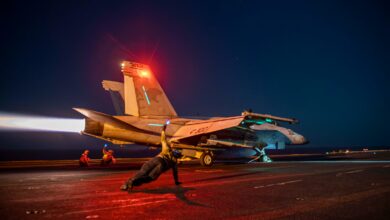US aerial war on drugs in Afghanistan fraught with risks
The U.S. strategy to cut off Taliban drug revenue by bombing heroin labs seems a daunting undertaking considering opium production grew by 87 percent in 2017 to a record level of 9,000 metric tons, according to a U.N. report. Not only is the task formidable, but using air power to counter drug trafficking may jeopardize the broader mission by misallocating resources and boosting the civilian death toll.
Last weekend the U.S. employed F-22 and B-52 bombers during a raid on a drug-processing factory in Afghanistan’s Helmand province, drawing the ire of local government officials who fear civilians could be harmed, The Washington Post reported on Tuesday.
Commander of U.S. Forces in Afghanistan General John Nicholson, in justifying the strategy, pointed out that the Taliban earned some $200 million a year from the drug trade. Hence, it seemed logical to employ such air power.
“We used an F-22 Raptor aircraft that can carry 250lbs bombs and hits direct targets … in the attack on a drug processing factory in Musa Qala, Helmand [on November 19],” Nicholson said. “F-22 Raptor aircrafts were used for the first time in Afghanistan.”
Nicholson said the U.S. will stand by Afghanistan in the fight against terrorism as well as the fight against drugs.
However, RAND Corporation Senior Political Scientist Jonah Blank told The Defense Post that the Pentagon is simply recycling a failed George W. Bush-era anti-drug strategy that will only burden the overall mission and alienate the local populace.
“Any counternarcotics effort is likely to result in civilian casualties … [and] corrupt use of resources – that is, targeting poorly-connected traffickers to the benefit of traffickers who’ve made the proper payoffs,” Blank, an anthropologist by training, explained.
That is why the Obama administration shut down his predecessor’s counternarcotics program, he said.
“The effort failed then, and is likely to fail now, for the same reasons,” Blank said.
Besides, he added, if the Taliban have not already begun moving their processing centers to populated areas, they will do so quickly. So the limited upside fails to outweigh the myriad risks that go beyond civilian deaths.
“A less-known risk is the drawing away of desperately needed resources that could be used elsewhere,” Blank explained. “U.S. aircraft are enormously expensive to operate: The cutting-edge F-22 cost $70,000 per flight-hour, and that doesn’t even include the cost of maintenance.”
To the extent that an anti-drug mission should be prioritized at all, it should be left to Afghan forces on the ground, he said.
U.S. air cooperation, meanwhile, should be focused on basic and vital missions like medical evacuation, troop transport, and close air support. And the U.S. military should be training Afghan pilots on sustainable aircraft.
“That means simpler, hardier, lower-tech platforms like MI-17 helicopters instead of U.S. Blackhawks for rotary-wing operations, and C-130 variants rather than jets – let alone advanced platforms like F-22s – for many fixed-wing missions,” Blank said.
Gretchen Peters, the President of the Center on Illicit Networks and Transnational Organized Crime and a member of the Organisation for Economic Co-operation and Development Task Force on illegal trafficking, told The Defense Post that while bombing drug refineries will certainly cut funding going to the Taliban leadership, on its own it will not counter Afghanistan’s drug problems.
“There needs to be a multi-pronged approach that combines tactics to reduce supply, reduce demand and fight corruption,” Peters said.
Striking drug labs, she continued, will result in a direct hit to Taliban finances, but other steps must be taken.
“The profits from the drug trade are not in Afghanistan, they are stashed in banks around the world,” Peters argued. “There needs to be a comprehensive effort to follow and seize that money.”
Brookings Institution scholar Michael O’Hanlon, while somewhat skeptical that the new strategy will bear much fruit, believes it is worth trying given the lack of options.
“Aerial eradication has a very mixed history, but in certain parts of Helmand in particular, it appears that all else has failed,” O’Hanlon told The Defense Post. “So my hopes aren’t high, but my objections if any are muted.”
University of Wisconsin-Madison Professor Alfred McCoy, author of In the Shadows of the American Century: The Rise and Decline of U.S. Global Power, in a recent article for TomDispatch.com argued that the record opium boom in Afghanistan was providing the Taliban endless funding for an endless war. He also cited the USAID-funded Helmand Food Zone where opium production is up by an unequalled 90 percent.
The professor told The Defense Post that amid this explosion in drug production the U.S. strategy is unlikely to put a dent in the Taliban’s finances.
“Given the country’s surging opium production, Gen. Nicholson’s bombing of a few reputed heroin labs to control Afghanistan’s poppy crop reminds one of King Canute reputedly raising his hand to command the tides,” McCoy concluded.












